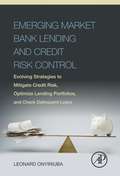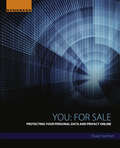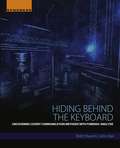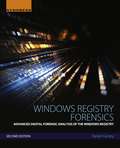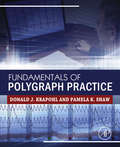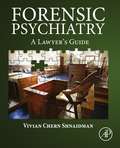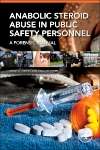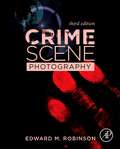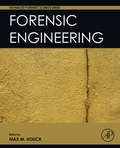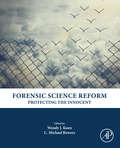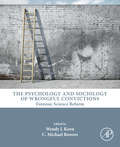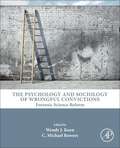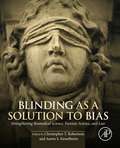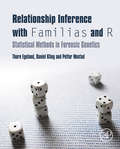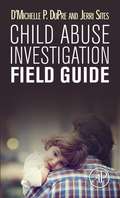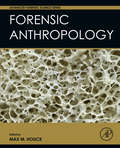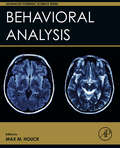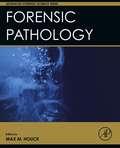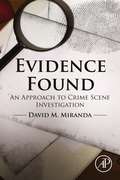- Table View
- List View
Human Body Decomposition
by Marc Oxenham Jarvis HaymanThe fate of the human body after death is a subject that has fascinated enquirers, both in the scientific and legal realms for millennia. However, objective research into the causes and nature of human decomposition has only taken place in the last two centuries, and quantitative measurement of the process as a means of estimating the time of death has only recently been attempted. The substantial literature concerning this research has been published in numerous scientific journals since the beginning of the nineteenth century. Human Body Decomposition expands on the current literature to include the evolving research on estimating the time of death. This volume details the process of decomposition to include early period after death when the body cools to ambient temperature, and when the body begins to putrefy. This process is significant because the estimation of the time of death becomes increasingly more difficult when the body begins to putrefy.Human Body Decomposition compiles a chronological account of research into the estimation of the time since death in human bodies found decomposed in order that researchers in the subject field can concentrate their thoughts and build on what has been achieved in the past.Provides concise details of research, over the last 200 years, of estimating the time of death in decomposed bodies.Covers methods of research into human decomposition in the stages of body cooling to ambient temperature and the later stages of autolysis, putrefaction and skeletonisation.Includes a detailed account of recent research and future concepts. Concludes with an account of the difficulties which future research into human decomposition will encounter.
Essentials of Medicolegal Death Investigation
by Matthew M. LunnEssentials of Medicolegal Death Investigation uses a unique approach by combining medical issues, injury patterns, and investigative procedures to provide the reader with the basic fundamentals for a death investigation. The text introduces the reader to death investigation, common causes of death, and very specific types of death, including blunt-force injuries, gunshot wounds, and toxicology deaths. Each section includes case studies with written and visual descriptions. Written by a well-known and experienced medicolegal death investigator, the book fills a void in medicolegal literature for both students and professionals alike.Provides a valuable guide to the interpretation of medical death investigation for practitioners and studentsCovers the following circumstances in death investigations: asphyxiation, blunt-force injuries, sharp-force injuries, gunshot wounds, toxicology deaths, and natural causesIncludes case studies with written and visual descriptions and discussion, as well as up-to-date literature review
Latent Print Processing Guide
by Stephen P. KasperLatent prints are chance or accidental impressions left by friction-ridge skin on a surface, regardless of whether they are visible or invisible at the time of deposition. Recognition of evidence that may contain fingerprints and the processes that can develop these latent prints is crucial in preventing valuable evidence from being left undetected. Latent Print Processing Guide goes beyond the basic police training, covering latent prints in detail and providing first responders with adequate training and guidelines. To process latent prints, examiners use various techniques including electronic, chemical, cyanoacrylate, and physical methods. Latent Print Processing Guide offers a broad understanding of latent print detection, development, and recovery, including insights on stateof-the-art technologies.Includes history of latent print identification and some of the pioneers and their contributions. Defines the differences between chemical and physical processes and explains process sequence protocols and recovery methods for different types of evidence.Chapters include: process selection, application and recovery, special considerations for specific materials, protocol sequence and process formulas, including required materials, application method, expected results, safety measures, and references.The text is written so that non-crime scene or non-crime laboratory personnel can also gain valuable information from it.
Forensic Psychology of Spousal Violence
by Mauro PaulinoExploring the dynamics between victim and offender is paramount to answering important issues of character and vital for forensic research. This involves examining the role of the victim during and after victimization; this process is especially important for spousal violence because of the interactive process between the victim and the offender.Forensic Psychology of Spousal Violence covers the phenomenon of spousal violence and its different forms, discussing the consequences of abuse, providing research tips to be used in the field, including relevant case studies and much more. The innovative approach of this text fills a void in the current understanding of spousal violence.Uses international statistics to present data of women battered and/or deceased to educate, change mindsets and practices and ultimately reduce the number of battered women and spousal homicides in the futureIncludes current case studiesIncludes best practices for spousal abuse investigationsPortable for use in fieldwork
Digital Forensics Trial Graphics: Teaching the Jury through Effective Use of Visuals
by John Sammons Lars DanielDigital Forensics Trial Graphics: Teaching the Jury Through Effective Use of Visuals helps digital forensic practitioners explain complex technical material to laypeople (i.e., juries, judges, etc.). The book includes professional quality illustrations of technology that help anyone understand the complex concepts behind the science. Users will find invaluable information on theory and best practices along with guidance on how to design and deliver successful explanations.Helps users learn skills for the effective presentation of digital forensic evidence via graphics in a trial setting to laypeople such as juries and judgesPresents the principles of visual learning and graphic design as a foundation for developing effective visualsDemonstrates the best practices of slide design to develop effective visuals for presentation of evidenceProfessionally developed graphics, designed specifically for digital forensics, that you can use at trialDownloadable graphics available at: http://booksite.elsevier.com/9780128034835
Data Breach Preparation and Response: Breaches are Certain, Impact is Not
by Kevvie FowlerData Breach Preparation and Response: Breaches are Certain, Impact is Not is the first book to provide 360 degree visibility and guidance on how to proactively prepare for and manage a data breach and limit impact. Data breaches are inevitable incidents that can disrupt business operations and carry severe reputational and financial impact, making them one of the largest risks facing organizations today. The effects of a breach can be felt across multiple departments within an organization, who will each play a role in effectively managing the breach. Kevvie Fowler has assembled a team of leading forensics, security, privacy, legal, public relations and cyber insurance experts to create the definitive breach management reference for the whole organization. Discusses the cyber criminals behind data breaches and the underground dark web forums they use to trade and sell stolen dataFeatures never-before published techniques to qualify and discount a suspected breach or to verify and precisely scope a confirmed breachHelps identify your sensitive data, and the commonly overlooked data sets that, if stolen, can result in a material breach Defines breach response plan requirements and describes how to develop a plan tailored for effectiveness within your organizationExplains strategies for proactively self-detecting a breach and simplifying a responseCovers critical first-responder steps and breach management practices, including containing a breach and getting the scope right, the first timeShows how to leverage threat intelligence to improve breach response and management effectivenessOffers guidance on how to manage internal and external breach communications, restore trust, and resume business operations after a breach, including the critical steps after the breach to reduce breach-related litigation and regulatory finesIllustrates how to define your cyber-defensible position to improve data protection and demonstrate proper due diligence practices
Emerging Market Bank Lending and Credit Risk Control: Evolving Strategies to Mitigate Credit Risk, Optimize Lending Portfolios, and Check Delinquent Loans
by Leonard OnyiriubaUsing a framework of volatile markets Emerging Market Bank Lending and Credit Risk Control covers the theoretical and practical foundations of contemporary credit risk with implications for bank management. Drawing a direct connection between risk and its effects on credit analysis and decisions, the book discusses how credit risk should be correctly anticipated and its impact mitigated within framework of sound credit culture and process in line with the Basel Accords. This is the only practical book that specifically guides bankers through the analysis and management of the peculiar credit risks of counterparties in emerging economies. Each chapter features a one-page overview that introduces its subject and its outcomes. Chapters include summaries, review questions, references, and endnotes.Emphasizes bank credit risk issues peculiar to emerging economiesExplains how to attain asset and portfolio quality through efficient lending and credit risk management in high risk-prone emerging economiesPresents a simple structure, devoid of complex models, for creating, assessing and managing credit and portfolio risks in emerging economiesProvides credit risk impact mitigation strategies in line with the Basel Accords
You: Protecting Your Personal Data and Privacy Online
by Stuart SumnerEverything we do online, and increasingly in the real world, is tracked, logged, analyzed, and often packaged and sold on to the highest bidder. Every time you visit a website, use a credit card, drive on the freeway, or go past a CCTV camera, you are logged and tracked. Every day billions of people choose to share their details on social media, which are then sold to advertisers. The Edward Snowden revelations that governments - including those of the US and UK – have been snooping on their citizens, have rocked the world. But nobody seems to realize that this has already been happening for years, with firms such as Google capturing everything you type into a browser and selling it to the highest bidder. Apps take information about where you go, and your contact book details, harvest them and sell them on – and people just click the EULA without caring. No one is revealing the dirty secret that is the tech firms harvesting customers’ personal data and selling it for vast profits – and people are totally unaware of the dangers. You: For Sale is for anyone who is concerned about what corporate and government invasion of privacy means now and down the road. The book sets the scene by spelling out exactly what most users of the Internet and smart phones are exposing themselves to via commonly used sites and apps such as facebook and Google, and then tells you what you can do to protect yourself. The book also covers legal and government issues as well as future trends. With interviews of leading security experts, black market data traders, law enforcement and privacy groups, You: For Sale will help you view your personal data in a new light, and understand both its value, and its danger.Provides a clear picture of how companies and governments harvest and use personal data every time someone logs onDescribes exactly what these firms do with the data once they have it – and what you can do to stop itLearn about the dangers of unwittingly releasing private data to tech firms, including interviews with top security experts, black market data traders, law enforcement and privacy groupsUnderstand the legal information and future trends that make this one of the most important issues today
Hiding Behind the Keyboard: Uncovering Covert Communication Methods with Forensic Analysis
by Brett Shavers John BairHiding Behind the Keyboard: Uncovering Covert Communication Methods with Forensic Analysis exposes the latest electronic covert communication techniques used by cybercriminals, along with the needed investigative methods for identifying them. The book shows how to use the Internet for legitimate covert communication, while giving investigators the information they need for detecting cybercriminals who attempt to hide their true identity. Intended for practitioners and investigators, the book offers concrete examples on how to communicate securely, serving as an ideal reference for those who truly need protection, as well as those who investigate cybercriminals.Covers high-level strategies, what they can achieve, and how to implement themShows discovery and mitigation methods using examples, court cases, and moreExplores how social media sites and gaming technologies can be used for illicit communications activitiesExplores the currently in-use technologies such as TAILS and TOR that help with keeping anonymous online
Windows Registry Forensics: Advanced Digital Forensic Analysis of the Windows Registry
by Harlan CarveyWindows Registry Forensics: Advanced Digital Forensic Analysis of the Windows Registry, Second Edition, provides the most in-depth guide to forensic investigations involving Windows Registry. This book is one-of-a-kind, giving the background of the Registry to help users develop an understanding of the structure of registry hive files, as well as information stored within keys and values that can have a significant impact on forensic investigations. Tools and techniques for post mortem analysis are discussed at length to take users beyond the current use of viewers and into real analysis of data contained in the Registry. This second edition continues a ground-up approach to understanding so that the treasure trove of the Registry can be mined on a regular and continuing basis.Named a Best Digital Forensics Book by InfoSec ReviewsPacked with real-world examples using freely available open source toolsProvides a deep explanation and understanding of the Windows Registry—perhaps the least understood and employed source of information within Windows systemsIncludes a companion website that contains the code and author-created tools discussed in the bookFeatures updated, current tools and techniquesContains completely updated content throughout, with all new coverage of the latest versions of Windows
Fundamentals of Polygraph Practice
by Donald Krapohl Pamela ShawThough polygraph has been the mainstay for government and police departments since World War II, it has undergone substantial transformation in recent years. Fundamentals of Polygraph Practice bridges the gap between the outmoded practices and today’s validated testing and analysis protocols. The goal of this reference is to thoroughly and concisely describe the evidence-based practices of polygraphy. Coverage will include: psychophysiology, testing techniques, data collection, data analysis, ethics, polygraph law, alternate technologies and much more. This text addresses the foundational needs of polygraph students, and is written to be useful and accessible to attorneys, forensic scientists, consumers of polygraph services, and the general public.Includes protocols and fundamentals of polygraph practiceCovers the history of lie detection, psychophysiology, data collection, techniques and testing, data analysis and much moreAuthors are internationally recognized in the polygraph field
Forensic Psychiatry: A Lawyer’s Guide
by Vivian ShnaidmanLawyers frequently encounter clients and/or cases of bizarre behavior, mental illness, substance abuse, psychopathy, sexual offenses, learning disorders, birth defects, and other behavioral and emotional issues. Often they are ill-prepared to understand the nature of the psychiatric report, how the psychiatric assessment was structured, and how to best utilize and challenge these reports in court.Forensic Psychiatry: A Lawyer’s Guide provides legal professionals the tools to identify mentally ill clients and help them navigate through the psychiatric information and language in reports and testimony. Topics include why a forensic psychiatrist is necessary, applications of psychiatry to law, various psychiatric disorders, and utilizing the expert witness.A user-friendly roadmap to psychiatry for the non-psychiatrist—covers why you need a forensic psychiatrist and the applications of psychiatry to lawProvides coverage of the mental status examination, common psychiatric diagnoses, treatable disorders versus brain damage, medical problems masquerading as mental illness, and much moreIncludes a full glossary of psychiatric terms as an additional easy reference guide
Anabolic Steroid Abuse in Public Safety Personnel: A Forensic Manual
by Brent E. Turvey Stan CrowderAnabolic Steroid Abuse in Public Safety Personnel: A Forensic Manual provides readers with information on both the history and overwhelming evidence relating to steroid abuse in the law enforcement subculture. The text raises awareness regarding the pervasiveness of the problem that has grown into a systemic and nationwide phenomenon, and then addresses the consequences of anabolic steroid abuse on individual health, agency liability, and public safety. Particular attention is paid to forensic issues, including investigative, evidentiary, and legal concerns, facilitating just and lawful outcomes when these crimes are suspected or exposed.Provides readers with information on both the history and overwhelming evidence relating to steroid abuse in the law enforcement subcultureAn investigative and forensic desk reference manual for investigators and attorneys Pays particular attention to forensic issues, including investigative, evidentiary, and legal concerns
Crime Scene Photography
by Edward M. RobinsonCrime Scene Photography, Third Edition, covers the general principles and concepts of photography, while also delving into the more practical elements and advanced concepts of forensic photography. Robinson assists the reader in understanding and applying essential concepts in order to create images that are able to withstand challenges in court. This text is a required reading by both the International Association for Identification’s Crime Scene Certification Board and the Forensic Photography Certification Board. Includes an instructor website with lecture slides, practical exercises, a test bank, and image collection and many videos which can be used.Extensively illustrated with over 1000 full color photographs, with many images entirely new for the third editionOver 100 practical exercises help the reader grasp the practical applicationsVariations of correct and incorrect approaches, to be used alongside practical exercises, available online in the Instructor’s ManualThe chapter on Special Photographic Situations includes new sections on autopsy photography, images from drones, recommendations to photographically document bloodstain patterns and firearms trajectories
Forensic Engineering
by Max M. HouckForensic Engineering, the latest edition in the Advanced Forensic Science series that grew out of recommendations from the 2009 NAS Report: Strengthening Forensic Science: A Path Forward, serves as a graduate level text for those studying and teaching digital forensic engineering, as well as an excellent reference for a forensic scientist’s library or for their use in casework. Coverage includes investigations, transportation investigations, fire investigations, other methods and professional issues. Edited by a world-renowned leading forensic expert, this series is a long overdue solution for the forensic science community. Provides basic principles of forensic science and an overview of forensic engineeringContains sections on investigations, transportation investigations, fire investigations and other methodsIncludes a section on professional issues, such as: from crime scene to court, forensic laboratory reports and health and safetyIncorporates effective pedagogy, key terms, review questions, discussion questions and additional reading suggestions
Forensic Science Reform: Protecting the Innocent
by Wendy J. Koen C. Michael BowersForensic Science Reform: Protecting the Innocent is written for the nonscientist to help make complicated scientific information clear and concise enough for attorneys and judges to master. This volume covers physical forensic science, namely arson, shaken baby syndrome, non-accidental trauma, bite marks, DNA, ballistics, comparative bullet lead analysis, fingerprint analysis, and hair and fiber analysis, and contains valuable contributions from leading experts in the field of forensic science.Offers training for prosecuting attorneys on the present state of the forensic sciences in order to avoid reliance on legal precedent that lags decades behind the scienceProvides defense attorneys the knowledge to defend their clients against flawed scienceArms innocence projects and appellate attorneys with the latest information to challenge convictions that were obtained using faulty scienceUses science-specific case studies to simplify issues in forensic science for the legal professionalOffers a detailed overview of both the failures and progress made in the forensic sciences, making the volume ideal for law school courses covering wrongful convictions, or for undergraduate courses on law, legal ethics, or forensics
The Psychology and Sociology of Wrongful Convictions: Forensic Science Reform
by Wendy J. Koen C. Michael BowersWrongful convictions are the result of faulty or false scientific evidence in 50% of the cases. Defense counsel is often at a great disadvantage in defending against evidence based on science. Illusory Evidence: The Psychology and Sociology of Wrongful Convictions is written for the non-scientist, to make complicated scientific information clear and concise enough for attorneys and judges to master. This is obtained by providing case studies to simplify issues in forensic psychology for the legal professional.Increases the courts’ knowledge about areas of psychology that have been debunked, have advanced, or have been refined by the scientific communityCovers issues in psychological forensics, namely: Profiling, Psychological Defenses, Mitigation, Eyewitness Testimony/Identification, Child Testimony, Repressed Memories, False Confessions and Moral PanicTrains prosecuting attorneys about the present state of the forensic psychology, to avoid relying only on legal precedent and will not present flawed science to the courtProvides defense attorneys the knowledge necessary to competently defend where forensic psychology plays a part in a prosecutionArms innocence projects and appellate attorneys with the latest information to challenge convictionsUses case studies to simplify issues in forensic psychology for the legal professional
The Psychology and Sociology of Wrongful Convictions: Forensic Science Reform (PDF)
by Edited by Wendy J. Koen C. Michael BowersWrongful convictions are the result of faulty or false scientific evidence in 50% of the cases. Defense counsel is often at a great disadvantage in defending against evidence based on science. Illusory Evidence: The Psychology and Sociology of Wrongful Convictions is written for the non-scientist, to make complicated scientific information clear and concise enough for attorneys and judges to master. This is obtained by providing case studies to simplify issues in forensic psychology for the legal professional: Increases the courts’ knowledge about areas of psychology that have been debunked, have advanced, or have been refined by the scientific community; Covers issues in psychological forensics, namely: Profiling, Psychological Defenses, Mitigation, Eyewitness Testimony/Identification, Child Testimony, Repressed Memories, False Confessions and Moral Panic; Trains prosecuting attorneys about the present state of the forensic psychology, to avoid relying only on legal precedent and will not present flawed science to the court; Provides defense attorneys the knowledge necessary to competently defend where forensic psychology plays a part in a prosecution; Arms innocence projects and appellate attorneys with the latest information to challenge convictions; Uses case studies to simplify issues in forensic psychology for the legal professional.
Blinding as a Solution to Bias: Strengthening Biomedical Science, Forensic Science, and Law
by Christopher T. Robertson Aaron S. KesselheimWhat information should jurors have during court proceedings to render a just decision? Should politicians know who is donating money to their campaigns? Will scientists draw biased conclusions about drug efficacy when they know more about the patient or study population? The potential for bias in decision-making by physicians, lawyers, politicians, and scientists has been recognized for hundreds of years and drawn attention from media and scholars seeking to understand the role that conflicts of interests and other psychological processes play. However, commonly proposed solutions to biased decision-making, such as transparency (disclosing conflicts) or exclusion (avoiding conflicts) do not directly solve the underlying problem of bias and may have unintended consequences. Robertson and Kesselheim bring together a renowned group of interdisciplinary scholars to consider another way to reduce the risk of biased decision-making: blinding. What are the advantages and limitations of blinding? How can we quantify the biases in unblinded research? Can we develop new ways to blind decision-makers? What are the ethical problems with withholding information from decision-makers in the course of blinding? How can blinding be adapted to legal and scientific procedures and in institutions not previously open to this approach? Fundamentally, these sorts of questions—about who needs to know what—open new doors of inquiry for the design of scientific research studies, regulatory institutions, and courts. The volume surveys the theory, practice, and future of blinding, drawing upon leading authors with a diverse range of methodologies and areas of expertise, including forensic sciences, medicine, law, philosophy, economics, psychology, sociology, and statistics.Introduces readers to the primary policy issue this book seeks to address: biased decision-making.Provides a focus on blinding as a solution to bias, which has applicability in many domains. Traces the development of blinding as a solution to bias, and explores the different ways blinding has been employed.Includes case studies to explore particular uses of blinding for statisticians, radiologists, and fingerprint examiners, and whether the jurors and judges who rely upon them will value and understand blinding.
Relationship Inference with Familias and R: Statistical Methods in Forensic Genetics
by Thore Egeland Daniel Kling Petter MostadRelationship Inference in Familias and R discusses the use of Familias and R software to understand genetic kinship of two or more DNA samples. This software is commonly used for forensic cases to establish paternity, identify victims or analyze genetic evidence at crime scenes when kinship is involved. The book explores utilizing Familias software and R packages for difficult situations including inbred families, mutations and missing data from degraded DNA. The book additionally addresses identification following mass disasters, familial searching, non-autosomal marker analysis and relationship inference using linked markers. The second part of the book focuses on more statistical issues such as estimation and uncertainty of model parameters. Although written for use with human DNA, the principles can be applied to non-human genetics for animal pedigrees and/or analysis of plants for agriculture purposes. The book contains necessary tools to evaluate any type of forensic case where kinship is an issue.This volume focuses on the core material and omits most general background material on probability, statistics and forensic geneticsEach chapter includes exercises with available solutionsThe web page familias.name contains supporting material
Child Abuse Investigation Field Guide
by D'Michelle P. DuPre Jerri SitesChildren are suffering from a hidden epidemic of child abuse and neglect. Every year more than 3 million reports of child abuse are made in the United States involving more than 6 million children. The United States has one of the worst records among industrialized nations – losing on average between four and seven children every day to child abuse and neglect. The WHO reports that over 40 million children, below the age of 15, are subjected to child abuse each year. Domestic violence in the home increases that risk threefold. Child Abuse Investigation Field Guide is intended to be a resource for anyone working with cases involving abuse, neglect or sexual assault of children. It is designed to be a quick reference and focuses on the best practices to use during a child abuse investigation. The guide explains the Minimal Facts Interview, the Forensic Interview, and the entire process from report to court. It is understood that every state has different statutes regarding these topics; however the objectives of recognizing, reporting, and investigating cases of this nature are the same. Just as every crime scene is different, every case involving a child is different. Best practices and standard procedures exist to help ensure cases are discovered, reported and investigated properly, to ensure good documentation is obtained to achieve prosecution and conviction. This field guide will be a useful tool for law enforcement, child protective services, social service caseworkers, child advocates, and other personnel and agencies working for the welfare of children.Includes protocols and best practices for child abuse investigationsExplains the Multidisciplinary Team approach and why it is usefulDescribes the Minimal Facts Interview and the Forensic InterviewWalks the reader from the initial report, through the investigation process, to pre-trial preparation and provides tips on court testimonyPortable and affordable, the guide is tabbed for easy access of specific information while in the field and can ensure that team members are “on the same page" throughout the investigation
Forensic Anthropology (ISSN)
by Max M. HouckForensic Anthropology serves as a graduate level text for those studying and teaching forensic anthropology, as well as an excellent reference for forensic anthropologist libraries or for use in casework. Covers taphonomy, recovery and analysis, identification, statistical interpretation, and professional issues. Edited by a world-renowned leading forensic expert, the Advanced Forensic Science Series grew out of the recommendations from the 2009 NAS Report, Strengthening Forensic Science: A Path Forward, and is a long overdue solution for the forensic science community.Provides the basic principles of forensic science and an overview of forensic anthropologyContains sections on taphonomy, recovery, analysis, pathology, and identificationCovers statistical interpretation of evidence using the classical-frequentist approach and Bayesian analysis, measurement uncertainty, and standard methodsIncludes a section on professional issues, such as: from crime scene to court, expert witness testimony, and health and safetyIncorporates effective pedagogy, key terms, review questions, discussion questions, and additional reading suggestions
Behavioral Analysis (ISSN)
by Max M. HouckBehavioral Analysis, the latest release in the Advanced Forensic Science series, an ongoing reference that grew out of recommendations from the 2009 NAS Report: Strengthening Forensic Science: A Path Forward serves as a graduate level text for those studying and teaching forensic psychology, and is also an excellent reference for forensic psychologists. Coverage includes investigations, death and violence, abuse, other methods and professional issues. Edited by a world-renowned, leading forensic expert, the Advanced Forensic Science series is a long overdue solution for those in the forensic science community.Provides basic principles of forensic science and an overview of forensic behavioral analysisContains sections on investigations, abuse, death and violence Includes coverage of other methods, such as phonetics and forensic linguisticsIncludes a section on professional issues, such as crime scene to court, expert witness testimony, health and safetyIncorporates effective pedagogy, key terms, review questions, discussion questions and additional reading suggestions
Forensic Pathology (ISSN)
by Max M. HouckForensic Pathology, the latest volume in the Advanced Forensic Science series that grew out of the recommendations from the 2009 NAS Report serves as a graduate level text for those studying and teaching forensic pathology, and is an excellent reference for forensic pathologists’ libraries or for use in their casework. Coverage includes postmortem interval, autopsy, trauma, causes of death, identification, and professional issues. Edited by a world-renowned leading forensic expert, this series provides a long overdue solution for the forensic science community. Provides basic principles of forensic science and an overview of forensic pathologyContains sections on postmortem interval, autopsy, trauma, causes of death, and identificationIncludes a section on professional issues, such as crime scene to court, expert witness testimony, health and safety, deaths in custody, and suicideIncorporates effective pedagogy, key terms, review questions, discussion questions, and additional reading suggestions
Evidence Found: An Approach to Crime Scene Investigation
by David MirandaEvidence Found: An Approach to Crime Scene Investigation is not another analysis of forensic errors using an "After the Fact" or "Lessons Learned" approach but a "Before the Fact" guide that examines the thought processes that can lead to those mistakes. Plus a few extras tips and tricks from the author’s experience of over 25 years. Many high-profile crime scene investigations (and routine ones, for that matter) have suffered errors that have had negative impact on the investigation result and in the courtroom. Typically, we examine what happened and develop a useful list of what to do and what not to do, fixing the symptoms but potentially leaving ourselves open to the same error type on the next scene. The reason? Many crime scene mistakes are the result of systemic issues that are repeated due to a failure to include an evaluation of the decision-making process, including our own foundations of knowledge. Through case study and logical argument, this book attempts to provide a framework to recognize, evaluate, and alter negative decision-making patterns, including evaluating our own experience, before they negatively impact an investigation or the overall operation of a forensic unit. Enhances the base concepts of evidence search and sequential processing for error avoidanceExamines the systemic areas/practices of a crime scene investigation where errors can occurIncludes a Evidence Matrix - a crime scene evaluation tool that aids in sequential processing decisionsContains tips on overcoming common crime scene issues, inlcuding night time searchesProvides courtroom Testimony - communicating comparison findings to a jury






